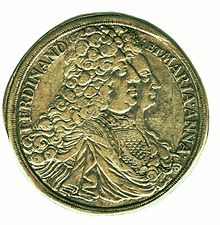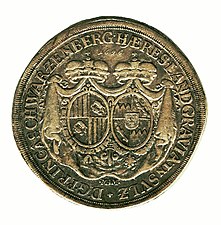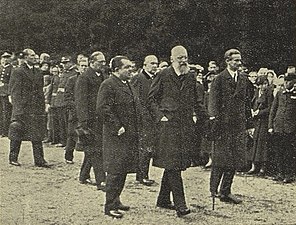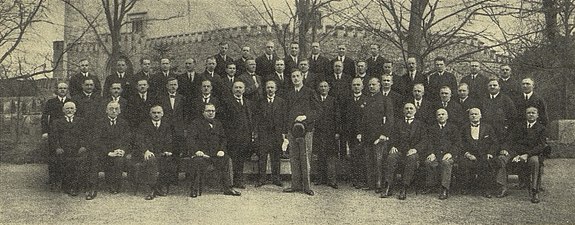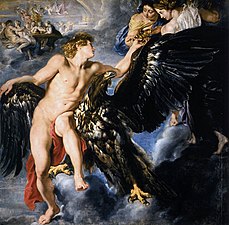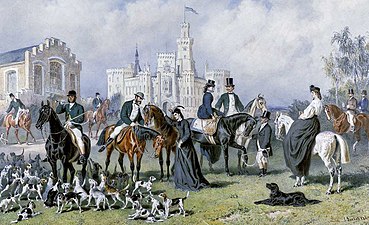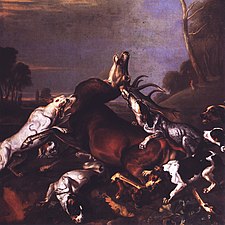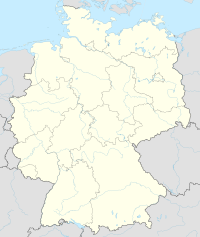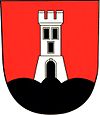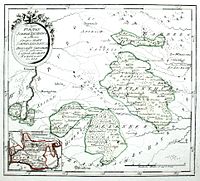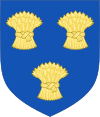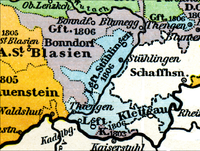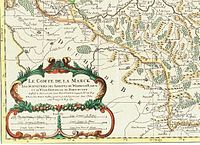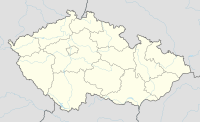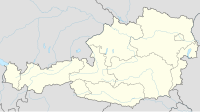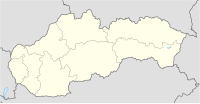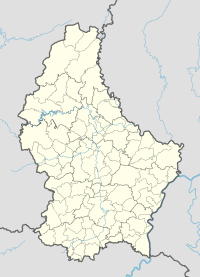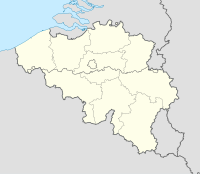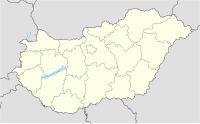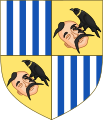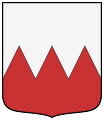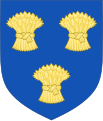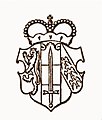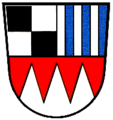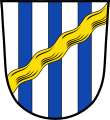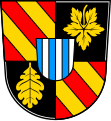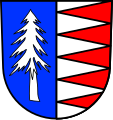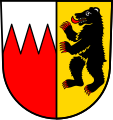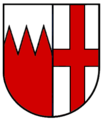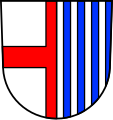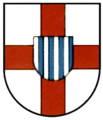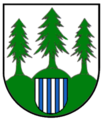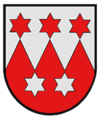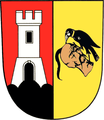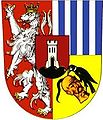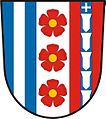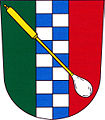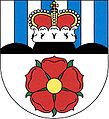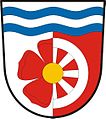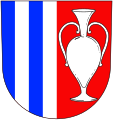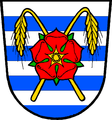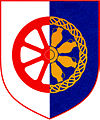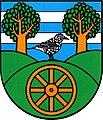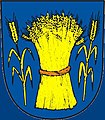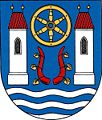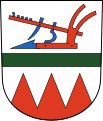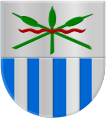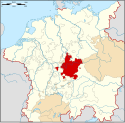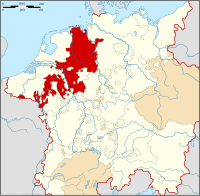House of Schwarzenberg
The House of Schwarzenberg is a German (Franconian) and Czech (Bohemian) aristocratic family, formerly one of the most prominent European noble houses. The Schwarzenbergs are members of the German and Czech nobility, and they once held the rank of Princes of the Holy Roman Empire. The family belongs to the high nobility and traces its roots to the Lords of Seinsheim during the Middle Ages.[1] The secundogeniture branch of the Schwarzenbergs was among the foremost Czech patriotic houses.
The current head of the family is Prince Johannes (born 1967), son and heir of the late Karel, 12th Prince of Schwarzenberg (1937–2023), a Czech politician who served as Minister of Foreign Affairs of the Czech Republic. The family owns properties and lands across Austria, the Czech Republic, Germany, and Switzerland.
History
[edit]Origin
[edit]The family stems from the Lords of Seinsheim, who had established themselves in Franconia during the Middle Ages.[1] A branch of the Seinsheim family (the non-Schwarzenberg portion died out in 1958) was created when Erkinger of Seinsheim acquired the Franconian territory of Schwarzenberg and the castle of Schwarzenberg in Scheinfeld during the early part of the 15th century. He was then granted the title of Freiherr (Baron) of Schwarzenberg in 1429. At that time, the family also possessed some fiefdoms in Bohemia.
Ascent and expansion
[edit]In 1599, the Schwarzenbergs were elevated to Imperial Counts, and the family was later raised to princely status in 1670.[1] In 1623 came the Styrian Dominion of Murau into the Schwarzenberg family due to the marriage of Count Georg Ludwig of Schwarzenberg (1586–1646) with Anna Neumann von Wasserleonburg (1535–1623). Furthermore, the House of Schwarzenberg acquired extensive land holdings in Bohemia in 1661 through a marriage alliance with the House of Eggenberg. In the 1670s, the Schwarzenbergs established their primary seat in Bohemia and, until 1918, their main residence was in Český Krumlov, Bohemia (now in Czech Republic).
Schwarzenberg/Sulz family unification
[edit]Due to the absence of a male heir and his only daughter Maria Anna married to Prince Ferdinand of Schwarzenberg, Johann Ludwig II Count of Sulz proposed a family unification between the Counts of Sulz and Princes of Schwarzenberg at the Imperial Court. His request was granted, which not only transferred all legal and property rights upon his death in 1687 from the Sulz family to the Schwarzenberg family, but assured that the Sulz family continues in the Schwarzenberg family. The visible affirmation of this bond was the merging of the coat of arms.
-
Alliance crest on Jinonice castle
-
Ferdinand & Maria Anna
-
Alliance crest on Schwarzenberg Ducat, which was the own currency issued by the House of Schwarzenberg
Two princely lines
[edit]At the beginning of the 19th century, the House of Schwarzenberg was divided into two princely-titled lines (majorats).[1] This division was already foreseen in the will of Prince Ferdinand (1652-1703). However, the absence of two male heirs until Joseph II and Karl I Philipp inhibited the execution. The senior branch, which held not only the Palais Schwarzenberg in Vienna, but also the Dominions of Scheinfeld, Krumlov, Frauenberg and Murau, died out in the male line in 1979 upon the death of Joseph III of Schwarzenberg, who was the 11th Prince of Schwarzenberg. The cadet branch, which was established by Karl Philipp, Prince of Schwarzenberg at Orlík Castle, continues to the present day.
The two branches have now been re-united under the father of the current head of the family, Karl VII of Schwarzenberg, who was the 12th Prince of Schwarzenberg. He was a Czech politician and served as Minister of Foreign Affairs of the Czech Republic.
-
The three last Princes of the primogeniture: Adolf (l.), Johann II (m.) and Josef III (r.)
-
The heir of both lines: Karl VII/I
-
The last Prince of the secundogeniture: Karl VI (m.)
Present time
[edit]Due to the unification of the family-headship under Karl VII Schwarzenberg, the fidei commissa of both the primogeniture / Hluboka line and the secundogeniture / Orlik line came under the single ownership of the last-mentioned prince. Karl VII created in the 1980s the current structure of the family belongings. The German and Austrian properties from the primogeniture were embedded (with some exceptions) into the Fürstlich Schwarzenberg'sche Familienstiftung (Princely Schwarzenberg Family-Foundation) based in Vaduz. The art collection, which includes the painting The Abduction of Ganymede by Peter Paul Rubens or an important collection of works by Johann Georg de Hamilton, is held in the separate Fürstlich Schwarzenberg'sche Kunststiftung (Princely Schwarzenberg Art-Foundation). The Czech property of the secundogeniture was held until 2023 privately. These properties were in their vast majority also transferred into the Fürstlich Schwarzenberg'sche Familienstiftung. The members of the family follow careers in the private or military sector.
-
RUBENS: The Abduction of Ganymede (between 1611 and 1612)
-
Hunting scene with the Princely family in front of Hluboká Castle in 1865
-
HAMILTON: Hirschhetze (1710)
Frisian and Prussian line
[edit]Michael II Baron zu Schwarzenberg (†1469), oldest son of Erkinger I (1362–1437), was married twice. First with Gertrud (Bätze) von Cronberg (†1438), from whom the princely line descends. His second marriage was with Ursula (Frankengrüner) Grüner (†~1484), from whom the Frisian and later the Prussian line originates. The children of Michael's and Ursula's alliance were never recognized by their half-siblings, as their first born son was born out of wedlock and the legitimisation only took place with the subsequent wedding.
Johann Onuphrius (1513–1584), a great-grandson of Michael II and Ursula, is considered to be the progenitor of the Frisian Line. His marriage with Maria von Grumbach (†1564) ensured Groot Terhorne Castle until 1879 as the family seat in the Netherlands. The Frisian line was made a member of the Dutch nobility by a Royal decree of King William I of the Netherlands on August 28, 1814. Henceforth, the Dutch version thoe Schwartzenberg en Hohenlansberg was applied for this branch of the family.
The Prussian Line was established as a cadet branch of the Frisian line with Georg Baron thoe Schwartzenberg en Hohenlansberg (1842–1918), who served as a Rittmeister in the Imperial German Army. He and his descendants were made members of the Prussian nobility by an Imperial decree, issued by Emperor Wilhelm II, and are entitled to carry the German title Freiherr.
Imperial immediate estates
[edit]The Schwarzenberg family held three Imperial Immediate Estates in the Holy Roman Empire.
By coincidence the coat of arms of the Princely Landgraviate of Klettgau and the Earldom of Buchan in Scotland are the same. The Klettgau coat of arms can be found in the left heart shield of the Schwarzenberg coat of arms.
Notable family members
[edit]The House of Schwarzenberg produced many military commanders, politicians, church dignitaries (including a Cardinal), innovators and patrons of the arts.[1] They were related to a number of European aristocratic families, notably the Lobkowicz (Czech: Lobkovicové) family. Some of the most noteworthy members of the Schwarzenberg family are:
| Name | Portrait | Arms | Office(s) | Marriage(s) Issue |
Comments |
|---|---|---|---|---|---|
| Erkinger VI of Seinsheim, 1st Baron of Schwarzenberg 1362 – 11 December 1437 |

|

|
Grand Master of the Hunt at the Court of the Bishopric of Würzburg | I. Anna von Bibra 1348 – 1408 Six children II. Barbara von Abensberg 1383 – 2 November 1448 Eleven children |
Founder of the Schwarzenberg family Member of the Imperial Council Military commander in the Hussite Wars |
| Johann, Baron of Schwarzenberg Johann the Strong 25 December 1463 – 21 October 1528 |
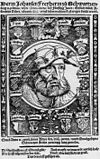
|

|
Judge of the episcopal court at Bamberg | Kunigunde, Countess of Rieneck 28 September 1469 – 18 October 1502 twelve children |
Friend of Martin Luther, and author of the Constitutio Criminalis Bambergensis, which was the basis for the Constitutio Criminalis Carolina |
| Wilhelm I, Baron of Schwarzenberg 1486 – KIA 1526 |

|
Field marshal | Katharina Wilhelmina von Nesselrode ? – 6 December 1567 two sons |
Field marshal of the Holy Roman Empire under Emperor Charles V in: German Peasants' War Guelders Wars | |
| Otto Heinrich, Count of Schwarzenberg Known among his contemporaries as inter viros sui temporis illustres illustrissimus 1535 – 11 August 1590 |
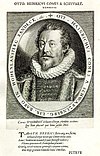
|

|
President of the Aulic Council Hofmarschall of the HRR by his Imp. Maj. decreed Guardian and Governor in Baden |
Elisa Margareta von Wolff Metternich ? – 6 February 1624 one son |
Guardian and Governor in Baden for Margrave Philip II of Baden President of the Aulic Council and Hofmarschall of the HRR under Maximilian II and Rudolf II |
| Melchior, Baron of Schwarzenberg ca. 1536 – KIA 29 June 1579 |

|
Military Commander Military Governor |
Anne de Merode-Houffalize ca. 1530 – 1580 |
Commander of the Dutch States Party military forces in the Siege of Maastricht and Military Governor of Maastricht | |
| Adolf, Count of Schwarzenberg ca. 1547 – 29 July 1600 |

|

|
Field marshal | Elisa Margareta von Wolff Metternich ? – 6 February 1624 one son |
Field marshal of the Holy Roman Empire and liberator of Raab, Hungary |
| Adam, Count of Schwarzenberg 1583 – 14 March 1641 |

|

|
Herrenmeister (Grand Master) Political advisor |
Margareta, Freiin von Palant von Larochette und Moestroff ? – 29 September 1615 two sons |
Advisor of George William, Elector of Brandenburg, Herrenmeister (Grand Master) of the Order of Saint John Son of Adolf, Count of Schwarzenberg |
| Georg Ludwig, Count of Schwarzenberg 24 December 1586 – 22 July 1646 |

|
Statesman | I. Anna Neumann von Wasserleonburg 25 November 1536 – 18 December 1623 no issue II. Maria Elisabeth Countess of Sulz 1587 – 12 December 1651 two sons |
Austrian statesman during the Thirty Years War Through his marriage with Anna Neumann came the Dominion of Murau into the Schwarzenberg family | |
| Ferdinand, 2nd Prince of Schwarzenberg The Plague King 23 May 1652 – 22 October 1703 |

|

|
Oberhofmarschall Oberhofmeister |
Maria Anna Countess of Sulz ca. 1660 – 18 July 1698 eleven children |
Oberhofmarschall and Oberhofmeister, known as the Plague King (Pestkönig) |
| Adam Franz, 3rd Prince of Schwarzenberg Duke of Krumlov 25 September 1680 – 11 Juni 1732 |

|

|
Obersthofmarschall (1711–1722) Oberstallmeister (1722–1732) |
Eleonore Princess of Lobkowicz 20 June 1682 – 5 May 1741 two children |
First Duke of Krumlov, Count of Sulz and Princely Landgrave of Klettgau in the Schwarzenberg family Initiator of the Schwarzenberg Navigational Canal Killed accidentally by Emperor Charles VI during a driven shoot |
| Joseph I, 4th Prince of Schwarzenberg Duke of Krumlov 15 December 1722 – 17 February 1782 |
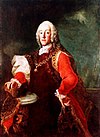
|

|
Obersthofmeister | Maria Theresia Princess von und zu Liechtenstein 28 December 1721 – 19 January 1753 nine children |
Obersthofmeister of Empress Maria Theresia, Minister of State, receives the Order of the Golden Fleece at the age of ten |
| Joseph II, 6th Prince of Schwarzenberg Duke of Krumlov 27 June 1769 – 19 December 1833 |

|

|
Ambassador | Pauline Princess of Arenberg-Aarschot 2 September 1774 – burned to death in the night of 1–2 July 1810 nine children |
Ambassador of the Austrian Empire in Paris Last Prince of Schwarzenberg, who possessed the imperial immediacy Founder of the Schwarzenberg Primogeniture |
| Karl Philipp Prince of Schwarzenberg 15 April 1771 – 15 October 1820 |

|
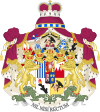
|
Field marshal Ambassador |
Maria Anna Countess von Hohenfeld widowed Princess Esterházy 20 May 1768 – 2 April 1848 three sons |
Austrian field marshal during the Napoleonic Wars and ambassador in St.Petersburg and Paris, Generalissimo of the Sixth Coalition in the Battle of the Nations at Leipzig Founder of the Schwarzenberg Secundogeniture |
| Ernst Prince of Schwarzenberg 29 May 1773 – 14 March 1821 |

|
 Bishop |
- | Canon of Cologne, Liège, Salzburg, Passau, Esztergom and Bishop of Győr | |
| Prince Felix of Schwarzenberg The Austrian Bismarck 2 October 1800 – 5 April 1852 |

|

|
Minister-President Minister of Foreign Affairs  Field Marshal Lieutenant |
Two children with Jane Digby, Lady Ellenborough | Minister-President of the Austrian Empire between 1848 and 1852 |
| Friedrich Prince of Schwarzenberg The Lansquenet 30 September 1800 – 6 March 1870 |

|

|
 Major General Writer |
- | Major general of the Austrian Empire, Colonel of the General Staff in the Spanish First Carlist War, officer in the Swiss Sonderbund War and author, known as der Landsknecht (the Lansquenet) |
| Karl II Prince of Schwarzenberg The Governor 21 January 1802 – 25 June 1858 |

|

|
 General of the branch (Military) Governor |
Josephine Countess Wratislaw of Mitrovic 16 April 1802 – 17 April 1881 one son |
General of the branch of the Austrian Empire, Military Governor of Milan and Governor of the Principality of Transylvania (today Romania), known as der Gouverneur (the governor) |
| Edmund Prince of Schwarzenberg 18 November 1803 – 17 November 1873 |

|

|
Field marshal |
- | Last Austrian field marshal in the 19th century |
| Friedrich Prince of Schwarzenberg 6 April 1809 – 27 March 1885 |
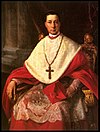
|

|
 Cardinal Archbishop Primas Germaniae Prince of the Church |
- | Cardinal and Archbishop of Salzburg, then Archbishop of Prague |
| Felix Prince of Schwarzenberg 8 June 1867 – 18 November 1946 |

|
 Major general |
Anna Princess zu Löwenstein-Wertheim-Rosenberg 28 September 1873 – 27 June 1936 five children |
Major general in World War I, one of only two recipients of the Golden Medal of Bravery for Officers by Emperor Charles I | |
| Heinrich Prince of Schwarzenberg Duke of Krumlov 29 January 1903 – 18 June 1965 |

|
Public servant | Eleonore Countess zu Stolberg-Stolberg 8 August 1920 – 27 Dezember 1994 one daughter |
Austrian public servant and survivor of the Buchenwald concentration camp | |
| Johannes Prince of Schwarzenberg 31 January 1903 – 26 May 1978 |

|
Public servant | Kathleen Vicomtesse de Spoelberch 19 May 1905 – 26 May 1978 two children |
Austrian ambassador in Italy (1947–1955), to the Holy See (1955–1966) and Ambassador to the Court of St James's (1966–1969), Director and Delegate of the Red Cross and member of the Governing Board | |
| Karel VI. Schwarzenberg 5 July 1911 – 9 April 1986 |

|

|
Officer Regent Author |
Antonia Princess zu Fürstenberg 12 January 1905 – 24 December 1988 four children |
Czech resistance fighter in World War II, Regent of the Grand Priory of Bohemia of the Order of Malta, historian and author |
| Karl, 12th Prince of Schwarzenberg 10 December 1937 - 12 November 2023 |

|

|
President of the Council of the European Union Minister of Foreign Affairs Vice prime minister Senator |
Therese Countess zu Hardegg auf Glatz und im Machlande 17 February 1940 two children |
Czech politician, former Minister of Foreign Affairs (Czech Republic) and head of the House of Schwarzenberg |
Property and residences
[edit]Germany
[edit]The Schwarzenberg family holding included the following residences in Germany:
| Name | Image | Location | Map | Comments |
|---|---|---|---|---|
| Schwarzenberg Castle | 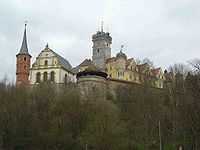
|
 Scheinfeld, Franconia |
Ancestral seat Held to present | |
| Stephansberg Castle | 
|
 Kleinlangheim, Franconia |
Acquired in 1243 through Apollonius The Older von Seinsheim. Sold through Siegismund von Schwarzenberg zu Hohenlandsberg in 1502 Destroyed in 1525 during the German Peasants' War. | |
| Hohenlandsberg Castle | 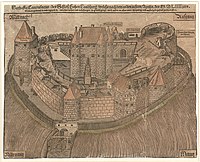
|
 Weigenheim, Franconia |
Acquired in 1436. Later main seat of the Schwarzenberg-Hohenlandsberg line Reconstructed in 1511 - 1524 Destroyed in 1554 during the Second Margrave War. | |
| Palais Schwarzenberg (Frickenhausen am Main) | 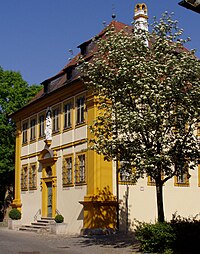
|
 Frickenhausen am Main, Lower Franconia |
||
| Wässerndorf Castle | 
|
 Wässerndorf in Seinsheim, Lower Franconia |
In the 12th centruty, the family (still known as Seinsheim / de Sovensheim) served as the ministerialis in Wässerndorf. From 1263, it served as the main seat of the Seinsheim family. After the line Seinsheim-Westerndorf died out, the castle came in 1550 in full possession of Count Friedrich zu Schwarzenberg, who rebuilt the castle from 1555 onwards. From 1910 onwards, the family ′′′von Pölnitz′′′ lived in the castle. The castle was burned down by American troops on 5 April 1945. | |
| Seehaus Castle | 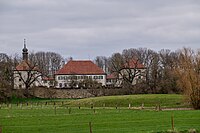
|
 Markt Nordheim, Middle Franconia |
Acquired in 1655. Held until the German land reform in 1947. | |
| Schnodsenbach Castle | 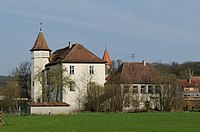
|
 Scheinfeld, Franconia |
Held from 1789 - 1816 | |
| Gimborn Castle | 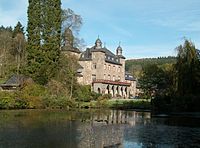
|
 Marienheide, North Rhine-Westphalia |
From 1631 on the residence in the imperial immediate Dominion of Gimborn of the Schwarzenberg Family Sold in 1782 to Johann Ludwig, Reichsgraf von Wallmoden-Gimborn | |
| Hückeswagen Castle | 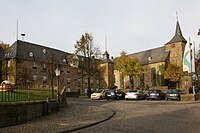
|
 Hückeswagen, North Rhine-Westphalia |
Received in 1631 as a fief 1653 loss of control due to occupation 1675 waiver of the fief by compensation | |
| Haus Lay Water Castle | 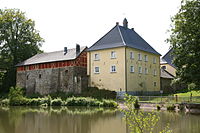
|
 Lay in Engelskirchen, North Rhine-Westphalia |
Acquired in 1654 1695 Reconstruction of the castle Sold in 1782 | |
| Neuenberg Castle | 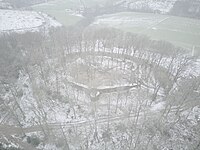
|
Scheel in Lindlar, North Rhine-Westphalia |
Acquired in 1629 1640 conquered and destroyed by the Swedes in the Thirty Years' War Ultimately demolished in 1663 Sold in 1782 | |
| Linzenich Castle | 
|
 Bourheim in Jülich, North Rhine-Westphalia |
Acquired in 1606 Reconstruction of the castle chapel by the Schwarzenberg family Sold in 1645 | |
| Tiengen Castle | 
|
 Waldshut-Tiengen, Baden-Württemberg |
Acquired in 1687 Sold in 1812 | |
| Küssaburg Castle | 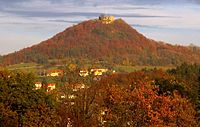
|
 Küssaberg, Baden-Württemberg |
Acquired in 1497 through the Sulz ancestors Destroyed but kept as a ruin in 1634 Sold in 1812 | |
| Jestetten Castle Oberes Schloss |
 Jestetten, Baden-Württemberg |
Acquired in 1488 through Count Alwig X. von Sulz Second main residence of the Sulz family after Tiengen Became a part of the Schwarzenberg property through the family-unification Sold together with the entire Principality | ||
| Jestetten Fortress Unteres Schloss Greuthsches Schlösschen |
 Jestetten, Baden-Württemberg |
Acquired in 1707 Sold together with the entire Principality | ||
| Willmendingen Castle | 
|
 Wutöschingen, Baden-Württemberg |
Acquired in 1801 Sold in 1812 | |
| Illereichen Castle | 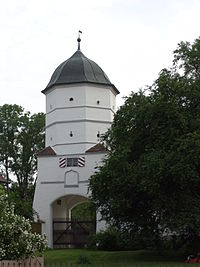
|
 Altenstadt, Bavarian Swabia |
Herrschaft Schwarzenberg, Amt Illereichen Acquired in 1788 Sold in 1834 | |
| Kellmünz Castle |  Kellmünz, Upper Swabia |
Herrschaft Schwarzenberg, Amt Kellmünz; Kellmünz becomes "Bavarian" and the Schwarzenberg family become Barons of the Empire of Kellmünz; Castle removed in 1809; Acquired in 1788; Sold in 1834 | ||
| Michelbach Castle | 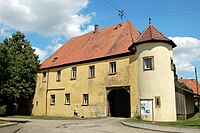
|
 Michelbach an der Lücke, Schwäbisch Hall |
Given to Georg Ludwig by Ferdinand II in 1631; Destroyed in the Thirty Years War and rebuilt until 1709; Lost in 1806 with the Rheinbundakte. | |
| Papenburg Castle Papenborch Castle Papenborg Castle |

|
 Papenburg, Emsland |
Given by Sybille von Plettenberg to her second husband Friedrich Freiherr von Schwarzenberg in 1620. Sold by him in 1630 to Drost Dietrich von Velen. |
Bohemia
[edit]
The Schwarzenberg land holdings in Bohemia included the Duchy of Krumlov, the town of Prachatice and Orlík Castle. The family also acquired the property of the House of Rosenberg (Czech: Rožmberkové). On their lands, the Schwarzenbergs created ponds, planted forests and introduced new technologies in agriculture.[1]
Upon the establishment of the Protectorate of Bohemia and Moravia in 1939, the possessions of Prince Adolph of Schwarzenberg were seized by the Nazi authorities. He managed to flee, but his cousin, Heinrich, Duke of Krumlov, was arrested and deported. After World War II, the Czechoslovakian government stated, by law No. 143/1947 from August 13, 1947 (Lex Schwarzenberg), that the assets of the Schwarzenberg-Hluboká primogeniture passed to the Land of Bohemia.[1]
The Schwarzenberg family holding included the following residences in Bohemia:
| Name | Image | Location | Map | Comments |
|---|---|---|---|---|
| Krumlov Castle Krumau Castle |
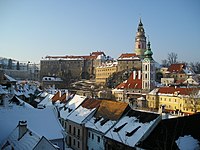
|
 Český Krumlov, South Bohemia |
Held from 1719 until the expropriation in 1947 UNESCO World Heritage Site One of the largest castles in the world | |
| Hluboká Castle Frauenberg Castle |
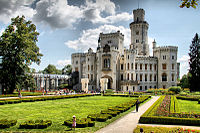
|
 Hluboká nad Vltavou, South Bohemia |
Acquired by Johann Adolf I of Schwarzenberg in 1661 Held until the expropriation in 1947 One of the finest examples of Neo-Tudor architecture in Historicism | |
| Vimperk Castle Winterberg Castle |
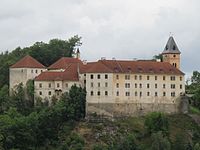
|
 Vimperk, South Bohemia |
Acquired in 1698 Held until the expropriation in 1947 | |
| Třeboň Castle Wittingau Castle |
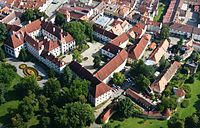
|
 Třeboň, South Bohemia |
Acquired in 1698 Held until the expropriation in 1947 | |
| Protivín Castle | 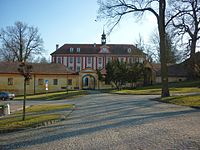
|
 Protivín, South Bohemia |
Acquired in 1711 Held until the expropriation in 1947 | |
| Kratochvíle Castle Kurzweil Castle |
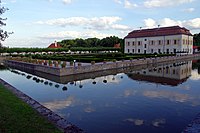
|
Netolice, South Bohemia | Inherited in 1719 from the Princes of Eggenberg Held until the expropriation in 1947 | |
| Červený Dvůr Castle Rothenhof Castle |

|
 Chvalšiny, South Bohemia |
Inherited in 1719 from the Princes of Eggenberg Held until the expropriation in 1947 | |
| Borovany Castle Forbes Castle |
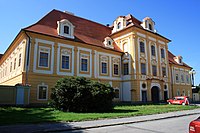
|
 Borovany, South Bohemia |
Acquired in 1789 in exchange for the Dominion of Vlčice (German: Wildschütz) Held until the expropriation in 1947 | |
| Dříteň Castle Zirnau Castle |
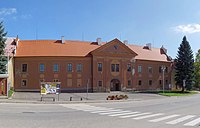
|
 Dříteň, South Bohemia |
Acquired in 1698 Held until the expropriation in 1947 | |
| Drslavice Fortress Drislawitz Fortress |
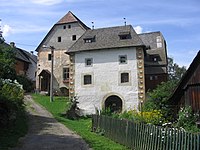
|
Drslavice, South Bohemia | Acquired in 1698 Held until the expropriation in 1947 | |
| Kestřany Castle Kesterschan Castle |
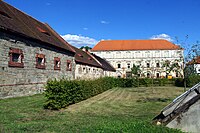
|
 Kestřany, South Bohemia |
Acquired in 1700 Held until the First Land Reform in 1924 | |
| Old Libějovice Castle | 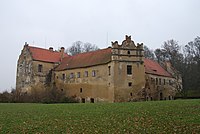
|
 Libějovice, South Bohemia |
Acquired in 1801 Held until the expropriation in 1947 | |
| New Libějovice Castle | 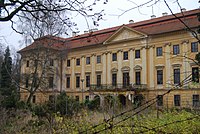
|
 Libějovice, South Bohemia |
Acquired in 1801 Rebuilt 1816 – 1817 Held until the expropriation in 1947 | |
| Ohrada Castle Wohrad Castle |
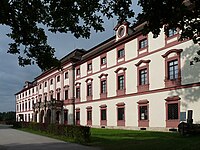
|
 Hluboká nad Vltavou, South Bohemia |
Built 1708 – 1713 Held until the expropriation in 1947 | |
| Chýnov |  Chýnov, South Bohemian Region |
Acquired in 1719 Held until the expropriation in 1947 | ||
| Postoloprty Castle Postelberg Castle |
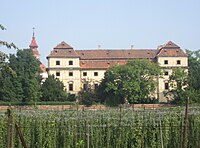
|
 Postoloprty, North Bohemia |
Acquired in 1692 Held until the expropriation in 1947 | |
| Nový Hrad Neuschloß Castle |
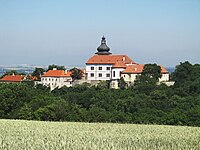
|
 Jimlín, Ústí nad Labem Region |
Acquired in 1767 Held until the expropriation in 1947 | |
| Lovosice Lobositz Castle |
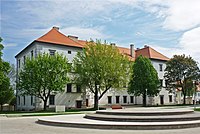
|
 Lovosice, Ústí nad Labem Region |
Acquired in 1783 Original seat of the Schwarzenberg Archives Held until the expropriation in 1947 | |
| Cítoliby Zittolieb or Zitolib Castle |
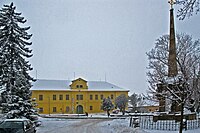
|
 Cítoliby, North Bohemia |
Acquired in 1803 Held until the First Land Reform in 1924 | |
| Domoušice Domauschitz Castle |
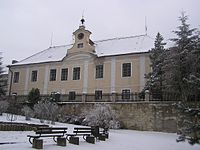
|
 Domoušice, North Bohemia |
Acquired in 1802 Held until the First Land Reform in 1924 | |
| Mšec Kornhauz Castle |
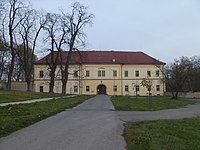
|
 Mšec, North Bohemia |
Held until the expropriation in 1947 | |
| Divice Fortress | 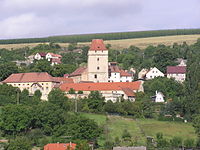
|
 Vinařice (Louny District), Ústí nad Labem Region |
Acquired in 1802 Held until the First Land Reform in 1924 | |
| Brodec Castle | 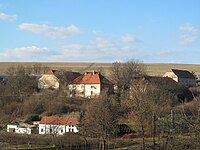
|
 Brodec (Louny District), Ústí nad Labem Region |
Acquired in 1802 Held until the First Land Reform in 1924 | |
| Dobrš Castle Dobrž Castle Dobersch Castle |
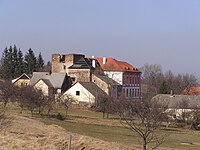
|
 Dobrš, South Bohemia |
Acquired in 1707 Sold in the 19th century. | |
| Vlčice Castle Wildschütz Castle |
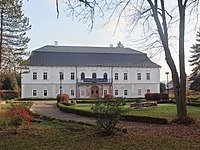
|
 Vlčice (Trutnov District) |
Acquired in 1675 Held until 1789 Exchanged for Borovany | |
| Břecštejn Castle Silberstein Castle |
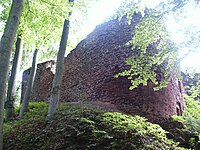
|
Hrádeček (Vlčice) | Acquired in 1675 Held until 1789 Exchanged for Borovany | |
| Pravda Castle | 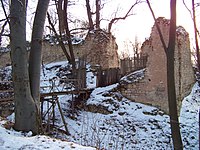
|
 Pnětluky, Ústí nad Labem Region |
Acquired in 1802 | |
| Orlík Castle Worlik Castle |
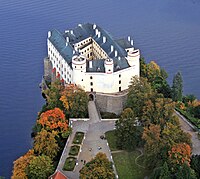
|
 Orlík nad Vltavou, South Bohemia |
Main residence of the Schwarzenberg Secundogeniture Restored in 1992 Held to present Publicly accessible | |
| Čimelice Castle | 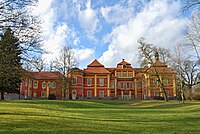
|
 Čimelice, South Bohemia |
Acquired in 1840 through the marriage of Karl II Schwarzenberg with Josefina Marie Wratislaw of Mitrovic Spring and summer residence of the Schwarzenberg Secundogeniture Restored in 1992 Held to present | |
| Karlov Castle | 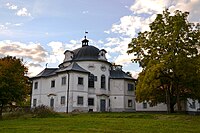
|
 Karlov (Smetanova Lhota), South Bohemia |
Restored in 1992 Held to present | |
| Varvažov Castle Warwaschau Castle |
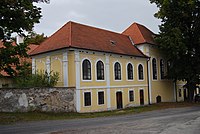
|
Varvažov, South Bohemia | Acquired in 1847 from the Sovereign Military Order of Malta Restored in 1992 Held to present | |
| Rakovice Castle | 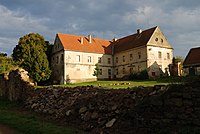
|
 Rakovice, South Bohemia |
Acquired in 1840 through the marriage of Karl II Schwarzenberg with Josefina Marie Wratislaw of Mitrovic Restored in 1992 Held to present | |
| Sedlec Castle Sedletz Castle |
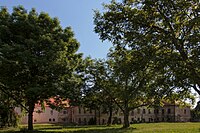
|
 Sedlec in the town of Kutná Hora, Central Bohemia |
Acquired in 1819 from the Cistercians Restored in 1992 Held to present | |
| Dřevíč Castle Grund Castle |
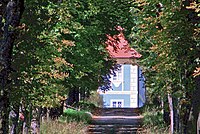
|
 Sýkořice, Central Bohemian Region |
Built by Joseph Wilhelm Ernst, Prince of Fürstenberg in the first half of the 18th century Sold by Maximilian Egon II, Prince of Fürstenberg to Czechoslovakia Acquired by Karel Schwarzenberg in 1991 Held to present | |
| Hunting lodge Tyrolský dům Tiroler Haus |
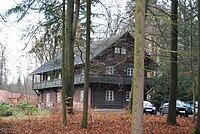
|
Květov, South Bohemia | Restored in 1992 Held to present | |
| Nový Dvůr Neuhof |
Obora u Cerhonic, South Bohemia | Acquired by Dr. Friedrich & Regula Schwarzenberg in the 1990s Held to present and main seat of Ferdinand Schwarzenberg | ||
| Tochovice Castle | 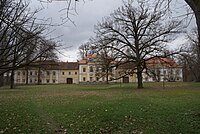
|
 Tochovice, South Bohemia |
Acquired in 1840 through the marriage of Karl II Schwarzenberg with Josefina Marie Wratislaw of Mitrovic Restored in 1992 Seat of Ernst Schwarzenberg's descendants Sold in 2022 | |
| Zbenice Castle | 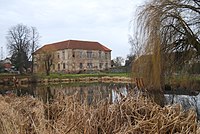
|
 Zbenice, Central Bohemian Region |
Acquired in 1805 through Karl I Schwarzenberg Held until 1948 | |
| Bukovany Castle Schloss Bukowan |
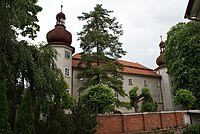
|
 Bukovany u Kozárovic, Central Bohemian Region |
Acquired in 1816 through Karl I Schwarzenberg Held until the First Land Reform in 1925 | |
| Zalužany Castle | 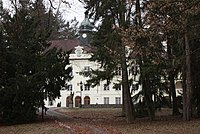
|
Zalužany, South Bohemia | Held until the First Land Reform in 1924 | |
| Osov Castle | 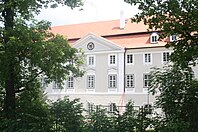
|
 Osov, South Bohemia |
Acquired in 1840.
Sold in 1927. | |
| Zvíkov Castle Zwingenberg Castle |
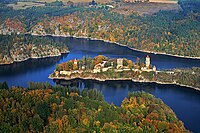
|
 Zvíkovské Podhradí, South Bohemia |
Held until 1948. In 1992 it was returned to the family and handed over to the care of the state.
Publicly accessible | |
| Starosedlský Hrádek Castle Altsattler Bürgel Castle |
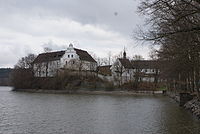
|
 Starosedlský Hrádek, Central Bohemia |
Held until 1948. | |
| Palais Schwarzenberg Schwarzenberský palác |
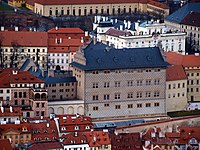
|
Prague |
Acquired in 1719 Held until the expropriation in 1947 Publicly accessible | |
| Palais Salm Salmovský palác Small Palais Schwarzenberg |
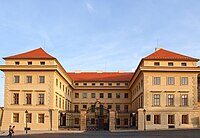
|
Prague |
Acquired in 1811 Held until the expropriation in 1947 | |
| Palais Deym Deymův palác |
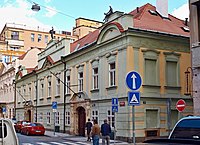
|
Prague |
Acquired in 1845 Prague seat of the Schwarzenberg Secundogeniture Held to present | |
| Palais Bissing Bissingenský palác Tatarkovic dům Schwarzenberský dům |
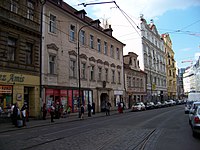
|
Prague |
Acquired in 1850 Consisting of two buildings: No. 90/17 (larger building with Schwarzenberg CoA) and No. 91/19. |
Austria
[edit]The Schwarzenberg family holdings included the following residences in Austria:
| Name | Image | Location | Map | Comments |
|---|---|---|---|---|
| Palais Schwarzenberg Gartenpalais Schwarzenberg |

|
Schwarzenbergplatz, Landstraße, Vienna |
Acquired in 1716 In the James Bond movie The Living Daylights it served as a film set Held to present | |
| Palais Schwarzenberg Winterpalais Schwarzenberg |

|
Neuer Markt, Innere Stadt, Vienna |
Acquired in 1688 1894 demolished | |
| Hirschstetten Castle | 
|
Hirschstetten, Vienna |
Acquired in 1713 Sold in 1750 | |
| Neuwaldegg Castle Villa Schwarzenberg |
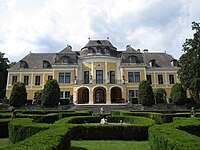
|
Hernals, Vienna |
Acquired in 1801 Sold in 1951 | |
| Palais Schwarzenberg | 
|
 Laxenburg, Lower Austria |
Acquired in 1703 Architect was Johann Lukas von Hildebrandt Sold in 1850 | |
| Palais Schwarzenberg | 
|
 Graz, Styria |
Acquired in 1775 Sold in 1853/54 | |
| Murau Castle Obermurau Castle |

|
 Murau, Styria |
Publicly accessible on appointment Held to present | |
| Grünfels Castle Old Castle |

|
 Murau, Styria |
Held to present | |
| Wintergrün Castle | 
|
 Ramingstein, Salzburg |
Held to present | |
| Schrattenberg Castle | 
|
 Scheifling, Styria |
Acquired by Prince Ferdinand in 1704 Main residence of the Schwarzenberg family in the Murtal until its destruction Total destruction through a fire, which occurred during restoration works, in 1915 Held to present | |
| Katsch Castle | 
|
 Teufenbach-Katsch, Styria |
Acquired in 1697 Partial deconstruction in 1838 Total destruction in 1858 Held to present | |
| Gusterheim Castle | 
|
 Pöls, Styria |
Acquired in 1698 by Prince Ferdinand together with the Dominions Reifenstein and Offenburg. The daughter of Prince Heinrich, Elisabeth von Pezold, Princess of Schwarzenberg, inherited the castle. Held to present by the Pezold family | |
| Ratzenegg Castle | 
|
 Moosburg, Carinthia |
Seat of the descendants of Prince Erkinger Held to present | |
| Tschakathurn Castle Schachenthurn Castle Schachenturm Castle |

|
 Scheifling, Styria |
Acquired in 1740 Total destruction through a fire in 1792 The daughter of Prince Johann II, Countess Ida Revertera von Salandra, Princess of Schwarzenberg, inherited the castle. Held to present by the Revertera family | |
| Goppelsbach Castle | 
|
 Stadl-Predlitz, Styria |
Acquired in 1839 Sold in 1938 | |
| Vöstenhof Castle | 
|
 Bürg-Vöstenhof, Lower Austria |
Acquired in 1937 through HSH Princess Therese Schwarzenberg; Inherited in 1945 by her daughter Countess Josephine Czernin. | |
| Hanfelden Castle | 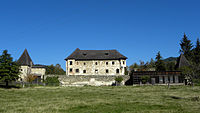
|
 Pölstal, formerly Unterzeiring in Oberzeiring, Styria |
Acquired in 1783 through HSH Prince Johann Schwarzenberg; Sold in 1856. |
Slovakia
[edit]The Schwarzenberg family holding included the following residence in Slovakia, which was part of the Lands of the Crown of Saint Stephen:
| Name | Image | Location | Map | Comments |
|---|---|---|---|---|
| Marianka Castle | 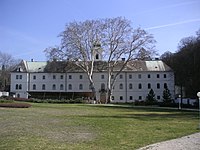
|
Marianka, Bratislava Region | Purchased by Friedrich "The Landsknecht" in 1839 |
Belgium and Luxembourg
[edit]The Schwarzenberg family holding included the following residence in today's Belgium and Luxembourg, while their main residence and burial place was in the city of Liège. Back then, the Spanish Netherlands, Prince-Bishopric of Liège and Duchy of Luxemburg were states within the Holy Roman Empire. The Schwarzenberg family held in this region the titles of Seigneur de Bierset et de Champlon.
| Name | Image | Location | Map | Comments |
|---|---|---|---|---|
| Fischbach Castle |  Fischbach Castle, Fischbach Fischbach Castle, Fischbach
|
 Fischbach, Canton of Mersch |
Inherited through the marriage of Johann Gerhard (1571 - 1635) with Dorothea de Naves (1629), heiress of Chiveri and Fischbach. | |
| Hassonville Castle |  Hassonville Castle, Marche-en-Famenne Hassonville Castle, Marche-en-Famenne
|
 Marche-en-Famenne, Luxembourg (Belgium) |
1603 Johann Gerhard acquired Humain and Hassonville. 1678: Sold to Etienne de Rossius de Liboy. | |
| Raeren Castle |  Raeren Castle, Raeren Raeren Castle, Raeren
|
 Raeren, Liège Province |
Mathias de Flamige, married with Wilhelmina de Notomb, sold the castle to Jean-Henri de Schwarzenberg bought the castle on 27 January 1790. However Baron Charles-Henri de Broich who was an in-law of the seller, bought back the estate and later sold it again to Baron Philippe de Witte de Limminghe. |
Ecclesiastical buildings and places
[edit]The following religious places are linked to the Schwarzenberg family either as burial or memorial places:
| Name | Image | Location | Map | Comments |
|---|---|---|---|---|
| Astheim Charterhouse | 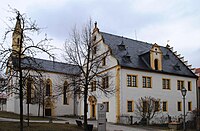
|
 Volkach, Franconia |
Founded by Erkinger, 1st Baron of Schwarzenberg in 1409 First burial site of the Schwarzenberg family | |
| Schwarzenberg Monastery | 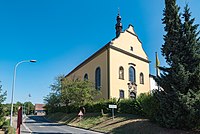
|
 Scheinfeld, Franconia |
Founded in 1702 | |
| St. Vitus Cathedral Schwarzenberg Chapel |
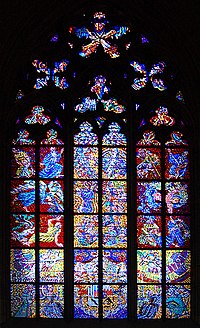
|
Prague, Czech Republic |
Located in the St. Vitus Cathedral. | |
| Schwarzenberg Crypt (Domanín) | 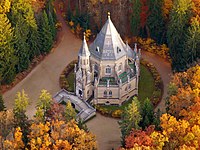
|
 Domanín (Jindřichův Hradec District), Czech Republic |
Constructed from 1874 – 1877. Burial site of the Schwarzenberg Primogeniture. In family possession Partially accessible to the public. | |
| Schwarzenberg Crypt (Orlík nad Vltavou) | 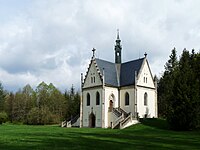
|
 Orlík nad Vltavou, Czech Republic |
Burial site of the Schwarzenberg Secundogeniture. In family possession Active in use and not open to the public. | |
| Sedlec Ossuary | 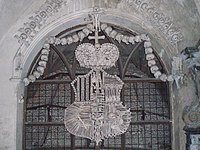
|
 Kutná Hora, Czech Republic |
Part of the World Heritage Site Sedlec Abbey Large Schwarzenberg Secundogeniture coat of arms made out of human bones. | |
| Zlatá Koruna Monastery Goldenkorn Monastery |
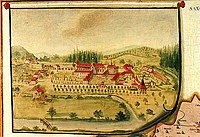
|
 Zlatá Koruna, Czech Republic |
Founded by King Ottokar II of Bohemia in 1263. The Schwarzenberg family inherited in 1719 the Jus patronatus of the Eggenberg family. In 1785, the family acquired the monastery after its closure due to the Josephinist Reform. It was used as a manufacture until 1909. It was confiscated under the Lex Schwarzenberg in 1948. | |
| Vyšší Brod Monastery Goldenkorn Monastery |

|
 Vyšší Brod, Czech Republic |
Founded by Wok I von Rosenberg in 1259. The Schwarzenberg family inherited in 1719 the Jus patronatus of the Eggenberg family and kept it for more than a century until 1822. | |
| St. Laurentius Church | 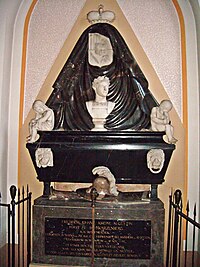
|
 Weinheim, Germany |
Tomb of Rittmeister Friedrich Prinz zu Schwarzenberg. | |
| All Saints' Church, Wittenberg | 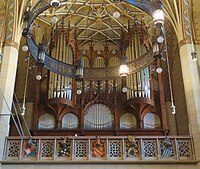
|
 Wittenberg, Germany |
World Heritage Site Site where the Ninety-five Theses were likely posted by Martin Luther in 1517. Schwarzenberg coat of arms on the balustrade of the organ to commemorate Johann of Schwarzenberg as one of Luther's first followers. | |
| San Gian Church Sankt Johannes |

|
 Celerina/Schlarigna, Switzerland |
The wooden ceiling from 1478, displaying the Brandis coat of arms, today embedded in the Schwarzenberg arms through the unification with Sulz, is considered one of the best preserved wooden church ceilings in Graubünden.
It shows the Coat of Arms of Bishop Ortlieb von Brandis (1458-1491), Lord of Brandis in Maienfeld. |
Monuments and memorials
[edit]The following monuments are erected for the Schwarzenberg family and its members:
| Name | Picture | Map | Comment |
|---|---|---|---|
| Schwarzenbergplatz | 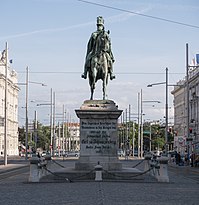
|
Inaugurated in 1867 Commemorating the victory of Karl Philipp Schwarzenberg at the Battle of the Nations in 1813 | |
| Monument to the Battle of the Nations | 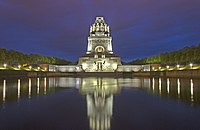
|
Inaugurated in 1913 Commemorating the victory (of Karl Philipp Schwarzenberg) at the Battle of the Nations in 1813 Length: 80 metres (260 ft) Width: 70 metres (230 ft) Height: 91 metres (299 ft) | |
| Monument to Karl Philipp SchwarzenbergKarlovy Vary | 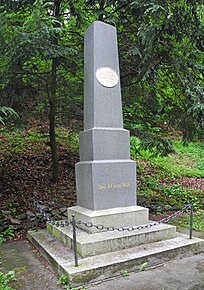
|
Installed in 1818, reconstructed in 1891 and 1991. | |
| Schwarzenberg-Pálffy Monument | 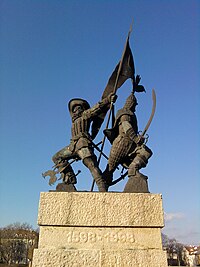
|
Inaugurated in 1998 Commemorating the victory at the Battle of Györ of Adolf Schwarzenberg in 1598 | |
| Statue of Cardinal Friedrich Schwarzenberg | Located in the St. Vitus Cathedral in the Prague Castle Memorial to Cardinal Friedrich Schwarzenberg | ||
| Schwarzenberg Monument in Meusdorf (Leipzig) | 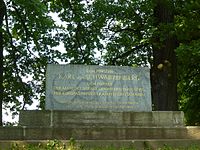
|
Inaugurated in 1838 Commemorating the victory of Karl Philipp Schwarzenberg at the Battle of the Nations in 1813 Commissioned by Karl Philipp's wife and his three sons | |
| Schwarzenberg Memorial on the peak of Plattenkogel Mountain | 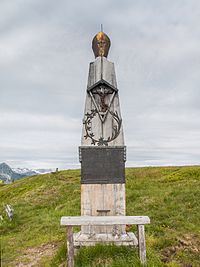
|
Commemorating the presence of Cardinal Friedrich Schwarzenberg | |
| Walhalla Memorial Bust of Karl Philipp Schwarzenberg |
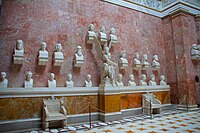 Second from the right in the lowest row |
Inaugurated in 1842 Commemorating the victory of Karl Philipp Schwarzenberg at the Battle of the Nations in 1813 The original bust was created by Johann Nepomuk Schaller in 1821 | |
| Ruhmeshalle (Munich) Bust of Karl Philipp Schwarzenberg |
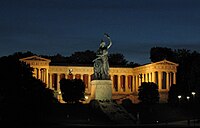
|
Inaugurated in 1853 | |
| Heldenberg Memorial Bust of Karl Philipp Schwarzenberg |
Inaugurated in 1849 One of four Schwarzenberg busts in the Heldenberg Memorial | ||
| Heldenberg Memorial Bust of Edmund Schwarzenberg |
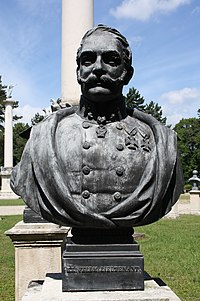
|
Inaugurated in 1849 One of four Schwarzenberg busts in the Heldenberg Memorial | |
| Heldenberg Memorial Bust of Adolf Schwarzenberg |

|
Inaugurated in 1849 One of four Schwarzenberg busts in the Heldenberg Memorial | |
| Heldenberg Memorial Bust of Felix Schwarzenberg |
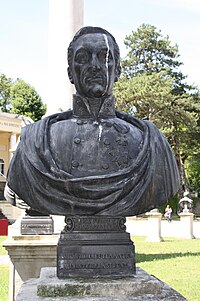
|
Inaugurated in 1849 One of four Schwarzenberg busts in the Heldenberg Memorial | |
| Thorvaldsen Museum Bust of Karl Philipp Schwarzenberg |
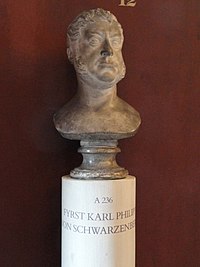
|
Created by Bertel Thorvaldsen | |
| Capuchin Church Bust of Schwarzenberg Uhlans Memorial |
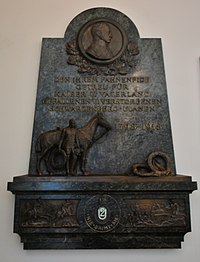
|
The same church is used as the Imperial Crypt of the Habsburg family | |
| Commemorative Obelisk Monument for Prince Karl II Schwarzenberg |

|
Inaugurated in 1858 Commemorating the decision of HSH Military-Governor Karl II to build a road between the districts Hermannstadt, Leschkirch, Agnetheln and Gross-Schenk. |
The family
[edit]Heads of the family and title progression
[edit]Lines (including Sulz offspring)
[edit]Source:[2]
 Sulz Alwig I. *1071 - †1095 |  Alaholfinger Erchanger ca. *860 - † ca. 917 | ||||||||||||||||||||||||||||||||||||||||||||||||||||||||||||||||||
 Seinsheim Conrad Son of Erchanger - | |||||||||||||||||||||||||||||||||||||||||||||||||||||||||||||||||||
 Seinsheim Apollonius the Older † ca. 1243 | |||||||||||||||||||||||||||||||||||||||||||||||||||||||||||||||||||
 Older Stephansberger Line Ältere Stephansberg'sche Linie Hildebrand † 1386 |  Younger Seinsheim Line Jüngere Seinsheim'sche Linie Friedrich - | ||||||||||||||||||||||||||||||||||||||||||||||||||||||||||||||||||
 Schwarzenberg Erkinger I. *1362 - † 1437 | |||||||||||||||||||||||||||||||||||||||||||||||||||||||||||||||||||
 Stephansberger Line Stephansberg'sche Linie Michael *1403 - † 1469 |  Hohenlandsberger Line Hohenlandsberg'sche Linie Sigismund *1430 - † 1502 | ||||||||||||||||||||||||||||||||||||||||||||||||||||||||||||||||||
 Dutch Line Niederländische Linie Wilhelm ⚔ 1526 |  Liége Line Lüttich'sche Linie Edmund - |  Frisian Line Frisische Linie Michael (*) - † 1489 |  Franconian Hohenlandsberger Line Fränkisch Hohenlandsberg'sche Linie - - |  Bavarian Hohenlandsberger Line Bayrisch Hohenlandsberg'sche Linie - - | |||||||||||||||||||||||||||||||||||||||||||||||||||||||||||||||
 Princely Line Fürstliche Linie Johann Adolf I. *1615 - †1683 |  Frisian Line Frisische Linie - - |  Prussian Line Preussische Linie Georg *1842 - † 1918 |  Older Bavarian Hohenlandsberger Line Ältere Bayrisch Hohenlandsberg'sche Linie Christoph I. †1538 - Georg Ludwig *1586 -†1646 | ← succession |  Younger Bavarian Hohenlandsberger Line Jüngere Bayrisch Hohenlandsberg'sche Linie Sebastian †1586 | ||||||||||||||||||||||||||||||||||||||||||||||||||||||||||||||
 Sulz Maria Anna †1698 ⚭ Ferdinand *1652 - †1703 | ← succession | ||||||||||||||||||||||||||||||||||||||||||||||||||||||||||||||||||
 Primogeniture or Hluboká Line Primogenitur oder Frauenberger Linie Joseph II. *1769 - †1833 |  Secundogeniture or Orlík Line Sekundogenitur oder Worliker Linie Karl I. Philipp *1771 - †1820 | ||||||||||||||||||||||||||||||||||||||||||||||||||||||||||||||||||
 United House Vereinigtes Haus Karl *1937 - †2023 | |||||||||||||||||||||||||||||||||||||||||||||||||||||||||||||||||||
Dynasty
[edit]The names hereby presented are those of all the direct successors of the Prince John I of Schwarzenberg (1742–1789). They have been respectively divided into the two branches of Krumlov and Orlik, including the contemporary generations. For the genealogy to be easier to consult, the male successors alone are listed, and they are accompanied with noteworthy information where necessary. In bold the names of the members of the eldest part of the family.
- Jan I Nepomuk (1742–1789), 5th Prince of Schwarzenberg, 10th (3rd of his line) Duke of Krumlov
- A1. Josef II Jan (1769–1833), 6th Prince of Schwarzenberg, 11th (4th of his line) Duke of Krumlov (1789–1833), founder of the main branch of the family (that of Frauenberg-Krummau)
- B1. Jan Adolf II (1799–1888), 7th Prince of Schwarzenberg, 12th (5th of his line) Duke of Krumlov (1833–1888)
- C1. Adolf Josef (1832–1914), 8th Prince of Schwarzenberg, 13th (6th of his line) Duke of Krumlov (1888–1914)
- D1. Jan II Nepomuk (1860–1938), 9th Prince of Schwarzenberg, 14th (7th of his line) Duke of Krumlov (1914–1938)
- E1. Adolph Jan (1890–1950), 10th Prince of Schwarzenberg, 15th (8th of his line) Duke of Krumlov (1938–1950)
- E2. Karl (1892–1919)
- E3. Edmund Černov (1897–1932), Called "Black Sheep" as a consequence of the refusal of his surname
- D2. Alois (1863–1937)
- D3. Felix (1867–1946), Major-General Austro-Hungarian Army
- E1. Josef III (1900–1979), 11th Prince of Schwarzenberg (1950–1979), last member of the eldest side of the dynasty
- E2. Heinrich (1903–1965), 16th (9th of his line) Duke of Krumlov (1950–1965) (adopted G1. Karel (VII/I))
- D4. Georg (1867–1952)
- D5. Karel (1871–1902)
- D1. Jan II Nepomuk (1860–1938), 9th Prince of Schwarzenberg, 14th (7th of his line) Duke of Krumlov (1914–1938)
- C2. Cajus (1839–1841)
- C1. Adolf Josef (1832–1914), 8th Prince of Schwarzenberg, 13th (6th of his line) Duke of Krumlov (1888–1914)
- B2. Felix (1800–1852), Prime Minister of the Austrian Empire
- B3. Friedrich (1809–1885), Archbishop of Prague
- B1. Jan Adolf II (1799–1888), 7th Prince of Schwarzenberg, 12th (5th of his line) Duke of Krumlov (1833–1888)
- A2. Karel I Philipp (1771–1820), Prince of Schwarzenberg, founder and chief of the second line of the family (Orlík)
- B1. Friedrich (1800–1870), who renounced his right of majorat in favour of his brother
- B2. Karel II (1802–1858)
- C1. Karel III (1824–1904)
- D1. Karel IV (1859–1913)
- E1. Karl V (1886–1914), Major Austro-Hungarian Army in WWI
- F1. Karel VI (1911–1989), Lieutenant Czechoslovak Army, Dr.phil.
- G1. Karel (VII / I) Schwarzenberg (1937–2023), 12th Prince of Schwarzenberg (1979–2023), 17th (10th of his line) Duke of Krumlov (1965–2023), former Minister of the Foreign Affairs and candidate to the head of state for the Czech Republic in 2013. He unified the two lines of the family.
- H1.Jan III Nepomuk (born 1967), 13th Prince of Schwarzenberg (from 2023), 18th (11th of his line) Duke of Krumlov (from 2023), current CEO of the family companies
- G2. Friedrich (1940–2014), Dr.rer.oec., Director at UBS and Mirabaud Group
- H1. Ferdinand (born 1989), Head of Region at Porsche, First Lieutenant Swiss Armed Forces, Forbes 30 under 30 (Czech edition, 2019)
- I1. Friedrich (born 2024), descendent through his mother from Empress Maria Theresa
- H1. Ferdinand (born 1989), Head of Region at Porsche, First Lieutenant Swiss Armed Forces, Forbes 30 under 30 (Czech edition, 2019)
- G1. Karel (VII / I) Schwarzenberg (1937–2023), 12th Prince of Schwarzenberg (1979–2023), 17th (10th of his line) Duke of Krumlov (1965–2023), former Minister of the Foreign Affairs and candidate to the head of state for the Czech Republic in 2013. He unified the two lines of the family.
- F2. Franz (1913–1992), Professor at Loyola University Chicago, Dr.jur.
- G1. Jan (born 1957), Officer of the United States, U.S. Navy Captain, former US Navy Special Operations Officer, Deputy Dir. of US Pacific Command's Joint Interagency Coordination Group for Counter-terrorism and Commander of the Combined Joint Task Force Paladin in Afghanistan
- H1. Alexander (born 1984), United States Armed Forces
- G1. Jan (born 1957), Officer of the United States, U.S. Navy Captain, former US Navy Special Operations Officer, Deputy Dir. of US Pacific Command's Joint Interagency Coordination Group for Counter-terrorism and Commander of the Combined Joint Task Force Paladin in Afghanistan
- F1. Karel VI (1911–1989), Lieutenant Czechoslovak Army, Dr.phil.
- E2. Ernst (1892–1979), Major Czechoslovak Army
- E3. Josef (1894–1894)
- E4. Johann von Nepomuk (1903–1978), Austrian Ambassador, Dr.jur.utr.
- F1. Erkinger (1933–2022), Dr. phil., archaeologist
- G1. Johannes (born 1963), Dr.rer.nat., Dr.med.univ.
- G2. Alexander (born 1971),
- H1. Karl Philipp (born 2003)
- F1. Erkinger (1933–2022), Dr. phil., archaeologist
- E1. Karl V (1886–1914), Major Austro-Hungarian Army in WWI
- D2. Friedrich (1862–1936)
- D1. Karel IV (1859–1913)
- C1. Karel III (1824–1904)
- B2. Leopold (1803–1873), Austrian Marshal
- A1. Josef II Jan (1769–1833), 6th Prince of Schwarzenberg, 11th (4th of his line) Duke of Krumlov (1789–1833), founder of the main branch of the family (that of Frauenberg-Krummau)
Family tree: secundogeniture
[edit] Schwarzenberg Secundogeniture Orlik Branch | |||||||||||||||||||||||||||||||||||||||||||||||||||||||||||||||||||||||||||||||||||||||||||||||||||||||||||||||||||||||||||||||||
Karl I Philipp ⚭ Maria Anna Hohenfeld | |||||||||||||||||||||||||||||||||||||||||||||||||||||||||||||||||||||||||||||||||||||||||||||||||||||||||||||||||||||||||||||||||
Friedrich | Karl II ⚭ Josefina Marie Wratislaw | Edmund | |||||||||||||||||||||||||||||||||||||||||||||||||||||||||||||||||||||||||||||||||||||||||||||||||||||||||||||||||||||||||||||||
Karl III ⚭ Wilhelmine Oettingen-Wallerstein | Gabriele | Anna Maria ⚭ Ernst Waldstein | |||||||||||||||||||||||||||||||||||||||||||||||||||||||||||||||||||||||||||||||||||||||||||||||||||||||||||||||||||||||||||||||
| Anna Maria ⚭ Franz Anton Thun-Hohenstein | Gabriele ⚭ Franz Josef Silva-Tarouca | Karl IV ⚭ 1.Marie Theresia Kinsky 2.Ida Hoyos | Ida ⚭ Johann Karl Lazansky - Bukowa | Maria ⚭ Ferdinand Trauttmansdorf | |||||||||||||||||||||||||||||||||||||||||||||||||||||||||||||||||||||||||||||||||||||||||||||||||||||||||||||||||||||||||||||
Karl V ⚭ Eleonore Clam-Gallas | Eleonore ⚭ Johann Friedrich Hartig | Johannes ⚭ Kathleen de Spoelberch | Ernst ⚭ 1. Elisabeth Széchenyi 2. Mathilde Gerber | Joseph | Maria Wilhelmine | ||||||||||||||||||||||||||||||||||||||||||||||||||||||||||||||||||||||||||||||||||||||||||||||||||||||||||||||||||||||||||||
Karl VI ⚭ Antonie Fürstenberg | Heinrich ⚭ Eleonore Stolberg-Stolberg | Franz ⚭ Amálie Lobkowicz | Erkinger ⚭ 1. Elisabeth Constantinides 2. Claudia Brandis | Colienne ⚭ Maximilian Meran | Anna Maria ⚭ Adolf Bucher | ||||||||||||||||||||||||||||||||||||||||||||||||||||||||||||||||||||||||||||||||||||||||||||||||||||||||||||||||||||||||||||
| Marie Eleonore ⚭ Leopold-Bill Bredow | Karl ⚭ Therese Hardegg | Thomas Prinzhorn | Friedrich ⚭ Regula Schlegel | Anna Maria ⚭ Elmar Haxthausen | Ludmila ⚭ 1. Carl Hess 2.James Truman Bidwell jr. | Isabela ⚭ Louis Harnier | Jan ⚭ Regina Hogan | Johannes ⚭ Julia | Anna Gabriella ⚭ 1.Philipp Waechter 2.Adam P. Dixon | Alexander ⚭ 1.Annabel Dimitriadis 2.Elena Bonanno | Gaia ⚭ Loïc van Cutsem | Ida ⚭ Baudouin de Troostembergh | |||||||||||||||||||||||||||||||||||||||||||||||||||||||||||||||||||||||||||||||||||||||||||||||||||||||||||||||||||||
Johannes ⚭ 1.Diana Orgovanyi-Hanstein 2.Francesca Riario Sforza | Anna Carolina ⚭ Peter Morgan | Karl Philipp Prinzhorn ⚭ Anna Eltz | Marie | Ferdinand ⚭ Marie Friling | Alexander | Lara | Nicholas | Karl Philipp | Anna-Gabriella | Anna Elisabetta | |||||||||||||||||||||||||||||||||||||||||||||||||||||||||||||||||||||||||||||||||||||||||||||||||||||||||||||||||||||||
| Friedrich | |||||||||||||||||||||||||||||||||||||||||||||||||||||||||||||||||||||||||||||||||||||||||||||||||||||||||||||||||||||||||||||||||
Titles
[edit]Titles of the members of the family
[edit]| Styles of Princes(ses) of Schwarzenberg | |
|---|---|
 | |
| Reference style | His/Her Serene Highness |
| Spoken style | Your Serene Highness |
The title of the head of the princely family is:
- HSH The Prince of Schwarzenberg, Duke of Krumlov, Count of Sulz, Princely Landgrave of Klettgau
The title of the wife of the head of the family would be:
- HSH The Princess of Schwarzenberg, Duchess of Krumlov, Countess of Sulz, Princely Landgravine of Klettgau
- (German: I.D. die Fürstin zu Schwarzenberg, Herzogin von Krummau, Gräfin von Sulz, gefürstete Landgräfin im Klettgau)
The title of the first born son and heir of the family is:
- HSH The Hereditary Prince of Schwarzenberg, Duke of Krumlov, Count of Sulz, Landgrave of Klettgau
- (German: S.D. der Erbprinz zu Schwarzenberg, Herzog von Krummau, Graf von Sulz, Landgraf im Kledage)
The title of the wife of the first born son and heir of the family would be:
- HSH The Hereditary Princess of Schwarzenberg, Duchess of Krumlov, Countess of Sulz, Landgravine of Klettgau
- (German: I.D. die Erbprinzessin zu Schwarzenberg, Herzogin von Krummau, Gräfin von Sulz, Landgräfin im Klettgau)
The title of all other female members of the family is:
- HSH Princess Name of Schwarzenberg, Countess of Sulz, Landgravine of Klettgau
- (German: I.D. Prinzessin Name zu Schwarzenberg, Gräfin von Sulz, Landgräfin im Klettgau)
The title of all other male members of the family is:
- HSH Prince Name of Schwarzenberg, Count of Sulz, Landgrave of Klettgau
- (German: S.D. Prinz Name zu Schwarzenberg, Graf von Sulz, Landgraf im Klettgau)
Although the family is entitled to use the von und zu, only the zu is applied. Moreover, all members of the family are allowed to use the title Fürst / Fürstin. However, this is not anymore practiced since the late 19th century and the cognates refer to themselves as Prinz / Prinzessin.
Title progression
[edit] Baron of the Holy Roman Empire
Baron of the Holy Roman Empire
Preßburg 10.8.1429 Imperial Count
Imperial Count
Prague 5.6.1599- Landsmannschaft in Steiermark
6.4.1647 - Bohemian Inkolat
Regensburg 25.4.1654 - Hungarian Indigenat
1659  Princes of the Holy Roman Empire
Princes of the Holy Roman Empire
Vienna 14.7.1670- Grand Palatinate
Vienna 20.10.1671 - Members of the Imperial Diet
Vienna 22.8.1671 - Members of the Imperial Diet of Counts in Westphalia
13.4.1674 - Members of the Higher Nobility (Alter Herrenstand) in Lower Austria
Vienna 11.2.1694 - Members of the Imperial Diet of Swabian Princes
30.11.1696 - Endowment of two majorats
20.10.1703  Rise to Dukes of Krumlov
Rise to Dukes of Krumlov
1719- Bohemian Duke (of Krumlov)
Prague 25.9.1723 - Bohemian Princes (Fürst) for all family members
Vienna 5.12.1746 - Princes of the Holy Roman Empire (Reichsfürst) for all family members
Vienna 8.12.1746
Coat of arms
[edit]Family coat of arms
[edit]The ancestral arms of the Lords of Seinsheim consisted of six vertical stripes in silver and blue.[4] However, the Schwarzenberg family's original coat of arms has four silver and four blue vertical stripes. Moreover, it starts with silver on the heraldic right (mirror-inverted perspective).
The family became Freiherren (Barons) of Schwarzenberg in 1429, and a silver tower on a black hill was added to their coat of arms to represent the city Scheinfeld and Schwarzenberg Castle.[4]

In 1599, Adolf von Schwarzenberg became an Imperial Count, and was given by the emperor a quarter with a canting arms showing the head of a Turk being pecked by a raven. This was to commemorate Adolf's conquest on 19 March 1598 of the Turkish-held fortress and city Győr. The German name of the Hungarian town is Raab, which means raven.[5][6][7]
In 1670, the Schwarzenbergs were raised to princely status. However, only the marriage of Ferdinand, The 2nd Prince of Schwarzenberg (1652–1703) with Marie Anna Countess of Sulz (1653–1698), the daughter of Johann Ludwig II Count of Sulz (1626–1687), led to the augmenting of their coat of arms, with quarters added for the domains of Sulz, Brandis (canting arms: a brand) and the Landgraviate of Klettgau.[5][8] Due to the absence of a male heir, Count Rudolf requested at the imperial court that the two families should be consolidated. This was granted, which meant for the Schwarzenberg family not only to assume all titles, rights and duties of the Counts of Sulz, but also to inherit all of Rudolf's properties.
The last augmentation of the family coat of arms was granted by the Austrian Emperor Franz II/I, he rewarded Field Marshal Karl I Philipp Prince of Schwarzenberg with the right to bear the three-part arms of the Habsburg family with the addition of an upright standing sword. This unique distinction was granted to commemorate the field marshal's victory in the Battle of the Nations, where he was the Generalissimo of the Sixth Coalition.
The family motto is NIL NISI RECTUM (Nothing but the right thing).
Evolution
[edit]-
Ancient Coat of Arms
-
Stephansberger line
-
Franconian-Hohenlandsberg line
-
Dutch (princely) line
-
Primogeniture (princely line)
-
Secundogeniture (princely line)
Fields
[edit]-
House of Schwarzenberg
-
Sulz county and family
-
Brandis family
-
Augmentation of honour for the Siege of Győr in 1598
-
Princely County of Schwarzenberg
-
Princely Landgraviate of Klettgau
Variations
[edit]-
Lesser version (general)
-
Middle version (Primogeniture)
-
Greater version (Secundogeniture)
Flags
[edit]-
Flag
-
Banner of arms
Derivative arms
[edit]Traces of the Schwarzenberg family's coat of arms can be found in various district and municipal coats of arms, which can be linked to the family.
Germany
[edit]-
Coat of arms of the Landkreis Neustadt a.d.Aisch-Bad Windsheim
-
Coat of arms of the former Landkreis Scheinfeld
-
Former coat of arms of the Landkreis Kitzingen
-
Municipal coat of arms of Scheinfeld
-
Municipal coat of arms of Seinsheim
-
Municipal coat of arms of Marktbreit
-
Municipal coat of arms of Markt Nordheim
-
Municipal coat of arms of Martinsheim
-
Municipal coat of arms of Biebelried
-
Municipal coat of arms of Willanzheim
-
Coat of arms of the district Astheim in Volkach
-
Coat of arms of the district Dornheim in Iphofen
-
Municipal coat of arms of Weigenheim
-
Municipal coat of arms of Klettgau
-
Municipal coat of arms of Dietingen
-
Coat of arms of the former municipality of Gößlinge
-
Municipal coat of arms of Hohentengen am Hochrhein
-
Coat of arms of the district of Bergöschingen in Hohentengen am Hochrhein
-
Coat of arms of the district of Stetten in Hohentengen am Hochrhein
-
Municipal coat of arms of Lauchringen
-
Municipal coat of arms of Oberlauchringen
-
Municipal coat of arms of Mötzing
-
Municipal coat of arms of Schnelldorf
-
Municipal coat of arms of Degernau
-
Municipal coat of arms of Lottstetten
-
Municipal coat of arms of Iggensbach
-
Municipal coat of arms of Dürrenmettstetten
-
Municipal coat of arms of Sigmarswangen
-
Municipal coat of arms of Leinstetten
Czech Republic
[edit]-
District coat of arms of Prague 5
-
Municipal coat of arms of Orlík nad Vltavou
-
Municipal coat of arms of Protivín
-
Municipal coat of arms of Tochovice
-
Municipal coat of arms of Libějovice
-
Municipal coat of arms of Zvíkovské Podhradí
-
Municipal coat of arms of Modrava
-
Flag of Dobrá Voda u Českých Budějovic
-
Flag of Dolní Dvořiště
-
Municipal coat of arms of Domanín
-
Municipal coat of arms of Doňov
-
Municipal coat of arms of Dynín
-
Flag of Frymburk
-
Municipal coat of arms of Chýnov
-
Municipal coat of arms of Lenora
-
Municipal coat of arms of Neplachov
-
Municipal coat of arms of Nová Ves
-
Municipal coat of arms of Novosedly nad Nežárkou
-
Municipal coat of arms of Paseky
-
Municipal coat of arms of Mšec
-
Municipal coat of arms Kestřany
-
Municipal coat of arms Kostelec nad Vltavou
-
Municipal coat of arms Vlčice
Switzerland
[edit]-
Municipal coat of arms of Wasterkingen, Canton of Zürich
-
Municipal coat of arms of Rafz, Canton of Zürich
-
Municipal coat of arms of Hüntwangen, Canton of Zürich
-
Municipal coat of arms of Walterswil, Canton of Bern
-
Municipal coat of arms of Niederried bei Kallnach, Canton of Bern
Netherlands
[edit]Order of the Golden Fleece
[edit]The Distinguished Order of the Golden Fleece is a Catholic order of chivalry founded in 1430 in Bruges by Philip the Good, Duke of Burgundy, to celebrate his marriage to Isabella of Portugal.

Throughout the order's history, eighteen members of the Schwarzenberg family were knights of the highest order and distinction of the Habsburg empire. Their first member Georg Ludwig was admitted in 1627, while their youngest knight Joseph I. was admitted with only ten years of age, after the tragic death of his father. Twice were the Schwarzenbergs Doyen, the title of the oldest ranking member of the order: Joseph I. and Johann Adolph II.. A very rare honour was given to Field Marshal Edmund, by making a lesser born, ergo not a chief of a line, knight of the order. Six Schwarzenbergs were knighted by Emperor Franz Joseph.

References
[edit]- ^ a b c d e f g "Schwarzenbergs". Archived from the original on 30 June 2014. Retrieved 13 November 2016.
- ^ "Biographisches Lexikon des Kaiserthums Oesterreich". Retrieved 13 October 2023.
- ^ Gothaisches Genealogisches Handbuch Fürstliche Häuser 2018 GGH7
- ^ a b "European Heraldry :: House of Schwarzenberg". Archived from the original on 2 February 2014. Retrieved 13 November 2016.
- ^ a b "The Schwarzenberg Coat-of-arms". Archived from the original on 12 August 2016. Retrieved 13 November 2016.
- ^ Sugar, Peter F.; Hanák, Péter; Frank, Tibor, eds. (1990). A History of Hungary. Bloomington: Indiana University Press. p. 97.
- ^ Slater, Stephen (2013). The Illustrated Book of Heraldry: An International History of Heraldry and Its Contemporary Uses. Wigston, Leicestershire: Lorenz Books. pp. 234, 240–241. ISBN 978-0-7548-2659-0.
- ^ CRnet.cz. "Informační servis města Třeboně". Retrieved 13 November 2016.



